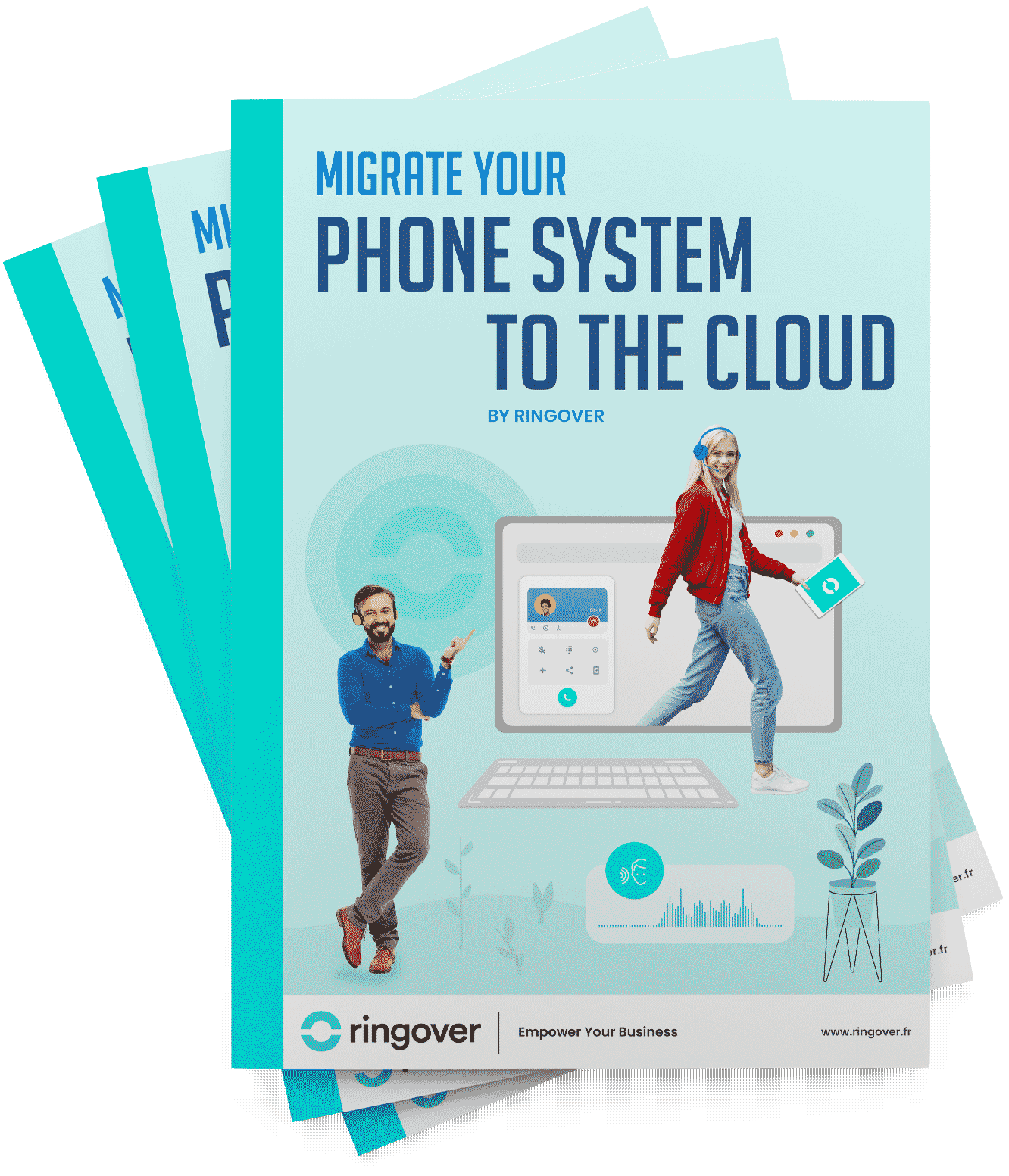Summary
- What is an Outgoing Call? (Definition and Advantages)
- What is an Incoming Call?
- Incoming Call vs. Outgoing Call: Differences Between the Two
- Are there laws regarding business phone activity?
- Focus on the importance of outbound calls
- 5 practical tips on outbound calls
- How to measure the effectiveness of outbound calls?
- What management tools are useful for business phone systems?
- Key points about inbound and outbound calls
Inbound calls and outbound calls are two types of telephone communication used in business. An incoming call is initiated by a customer or prospect towards the company, while an outgoing call is initiated by the company towards its customers or prospects. These two types of calls have different objectives and uses.
In this article, we will define these two concepts and go beyond trivial information to explain their differences and specificities. We will also address the importance of these calls, the current legislation, as well as tips and tools to optimize the management of incoming and outgoing calls in a company.
What is an Outgoing Call? (Definition and Advantages)
Outgoing calls are calls, often calls made via Internet, initiated by a company to its existing or potential customers or prospects. They are the opposite of incoming calls, which are initiated by customers to the company.
In business telephony, the primary objective of outgoing calls is to contact customers to offer products or services, answer their questions, make appointments, or provide after-sales service, for example. Outgoing calls can also be used for prospecting campaigns to expand the customer base.
The advantages of outgoing calls are numerous. They allow the company to take the initiative in contacting and being proactive in customer relations. This also provides better control over the delivered message. It's a simple way to maintain flexibility in planning commercial activities.
However, there's a slight drawback: outgoing calls can be perceived as intrusive by prospects. Therefore, it is important to ensure an effective strategy with suitable call center scripting software to maximize the chances of interesting prospects.
Great call management depends on having a variety of tools available, such as IVR menus, group routing, and analytics to understand performance.
What is an Incoming Call?
Incoming calls are phone calls received by a company from an external number. Their primary objective is to respond to customer requests and provide telephone support.
The advantages of incoming calls include:
- Directly responding to customer queries
- Obtaining valuable information about customers
- Providing personalized support
The disadvantages can be:
- Significant personnel costs to manage the calls
- Difficulty in anticipating and managing call peaks
- Risk of dissatisfaction if wait times are too long
Overall, incoming calls allow a company to offer quality customer service and build lasting relationships with customers. They are essential for companies looking to improve their image and reputation.
Incoming Call vs. Outgoing Call: Differences Between the Two
The main differences between incoming and outgoing calls are as follows:
- Call Initiation: An incoming call is received by a company, usually from a customer or prospect. An outgoing call is made by the company to a customer or prospect.
- Reasons for the Call: Incoming calls are generally for information requests, customer support, complaints, etc. Outgoing calls are mainly for prospecting, sales follow-ups, and surveys.
- Management: Inbound call centers manage customer calls, while outbound call centers proactively contact prospects.
- Staff Roles: Agents in inbound call centers have a reactive role, whereas agents in outbound call centers are proactive.
- Activity Planning: The volume of incoming calls is unpredictable, while outgoing calls are planned and the volume is controlled.
Are there laws regarding business phone activity?
In the United States, regulations govern both inbound and outbound calls to ensure fair practices and protect consumer rights. For outbound calls, the Telephone Consumer Protection Act (TCPA) of 1991 mandates that businesses obtain prior consent before making telemarketing calls to consumers. Additionally, calls to numbers on the National Do Not Call Registry are prohibited unless an exemption applies. Moreover, businesses must adhere to specific calling hours—typically from 8 a.m. to 9 p.m. local time—to avoid disrupting recipients outside of reasonable hours.
For inbound calls, while there are no specific federal laws governing them, businesses must still handle customer information responsibly under various privacy laws, such as the Health Insurance Portability and Accountability Act (HIPAA) for healthcare-related calls. Understanding and complying with these regulations are crucial for businesses aiming to maintain trust and legality in their telephone communications.
Focus on the importance of outbound calls
Outbound calls are essential for businesses for several reasons:
- They allow gathering valuable information about potential and existing customers. Agents can ask specific questions to better understand needs and motivations.
- They enhance the company's reputation and visibility. By calling customers directly, the company shows that it cares about their feedback.
- They provide an opportunity for follow-up after an interaction. Agents can ensure that customers are satisfied.
- They give more control to the company over the message. Agents can tailor their speech based on responses.
- They help establish more personal and warm relationships. Customers appreciate being contacted directly.
5 practical tips on outbound calls
Outbound calls are an excellent way for businesses to reach new customers and generate leads. However, it's important to prepare well for these calls to make them effective. Here are some tips for successful outbound calls:
- Know what is required by law in your business activities. There are regulations on the times people can be called and on call recording. Adhere to these rules to avoid issues.
- Be flexible and natural. Have an engaging conversation rather than reading a script word for word. Adapt to your caller.
- Stay focused. Prepare a quiet environment and make a list of key points to address during the call.
- Use voice and tone to capture attention. Vary your intonation and make strategic pauses.
- Prepare responses to common objections to respond adeptly.
By following these tips, you'll increase your chances of success and leave a positive impression of your company. Professional outbound calls require preparation but are highly rewarding.
How to measure the effectiveness of outbound calls?
It is essential to measure the effectiveness of outbound call campaigns to optimize performance. Here are some key analytics to track:
- Conversion Rate: The number of calls converted into sales or appointments compared to the total number of calls made. It helps measure commercial effectiveness.
- Pick-up Rate: The number of calls answered by the prospect compared to the total number of calls made. It helps measure the campaign's attractiveness.
- Average Conversation Duration: The time prospects spend on the phone. It helps evaluate the interest generated.
- Hang-up Rate: The number of prospects hanging up before the end of the call. It indicates whether the pitch is relevant.
To track these indicators, monitoring tools like those integrated into Ringover are useful. They allow real-time performance measurement and adjustment of call campaigns. Regular KPI analysis is essential to optimize the effectiveness of outbound call actions.
What management tools are useful for business phone systems?
For optimized management of inbound and outbound calls in a company, there are now numerous software and technological solutions. The era of the traditional landline phone is over. These tools allow for automating certain tasks, improving team efficiency, and better measuring performance.
- Call Center Software: These typically offer advanced features for managing call queues. They enable intelligent routing of calls to the right agents, optimizing wait times.
- Omnichannel Contact Center Software: Some tools even offer omnichannel communication capabilities, managing calls via different channels such as phone, chat, messengers, reviews, etc. This unifies customer interactions across all channels.
The best call center software often integrates smart routing, call recording, creation of sales scripts, and CRM integrations like Hubspot, Salesforce, Zendesk, and more. This allows optimizing team performance for both inbound and outbound calls.
Key points about inbound and outbound calls
In summary, inbound and outbound calls play complementary roles in a company's enterprise communication.
Inbound calls handle customer and prospect inquiries, while outbound calls are proactive, initiating contact. Both are essential for driving sales and enhancing company visibility.
Though subject to specific regulations, especially concerning telemarketing, outbound calls offer numerous advantages when targeted and ethically conducted. They enable reaching a wider audience, promoting new products and services, and fostering customer loyalty.
To maximize benefits, call center training is crucial, as is defining appropriate cold calling scripts, and regularly measuring outcomes. Call management tools are also invaluable for optimizing campaigns and daily operations.
Outbound and inbound calls will continue to play a central role in corporate marketing and sales strategies in the years ahead. Their effectiveness hinges on constant adaptation to customer expectations and evolving communication technologies.
Ringover can assist by providing all necessary communication and monitoring tools for your telephony needs, whether outbound or inbound. To learn more, start your free trial today!
Published on June 26, 2024.



